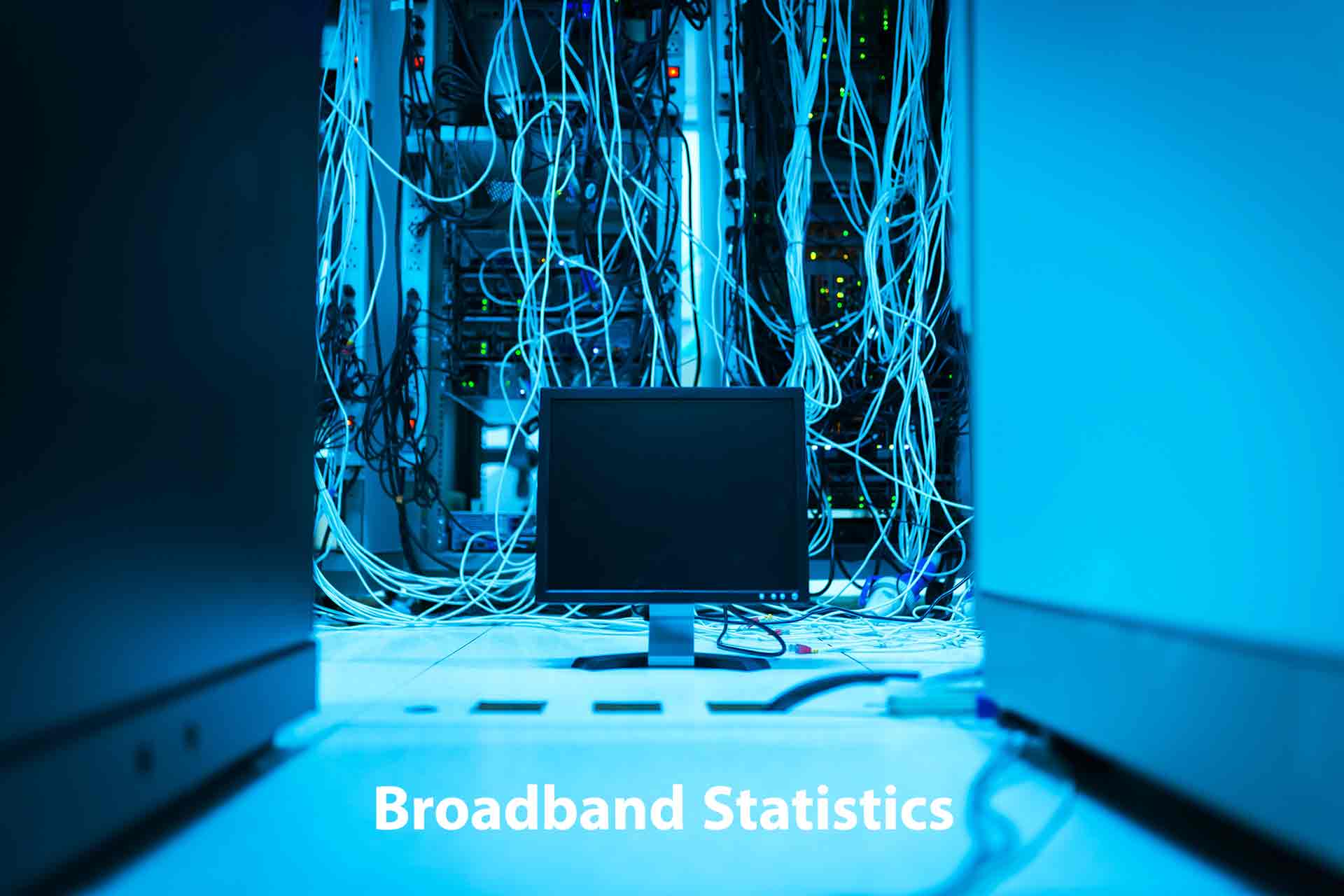15 Mindblowing Broadband Statistics to Know in 2025
7 min. read
Updated on
Read our disclosure page to find out how can you help VPNCentral sustain the editorial team Read more

The internet has drastically impacted how the world operates by transforming communication, business, banking, education, and more.
Broadband networks offer high-speed internet connections that come in the form of cable, DSL, fiber optic, and satellite.
Accordingly, fast and affordable broadband is making the US a leader in today’s digital economy by providing seamless connections.
So, if you’re interested in learning more about how these networks operate, read the fascinating broadband statistics below.
Stunning Broadband Statistics
Nowadays, broadband networks are in nearly every community across the globe, making it super convenient to stay connected and informed.
Here are some stunning worldwide broadband statistics:
- 99% of US homes have access to broadband connections of 25 Mbps or faster.
- Cable ISPs have invested over $185 billion in infrastructure and networks from 2012 to 2022 to meet user demands.
- The average download speed in the States hovers around 203 Mbps as of June 2022, up from 138 Mbps in March 2020.
- US cable broadband revenue beat $76.60 billion in 2022 and has grown at a higher annual clip than the overall economy for years.
- The global broadband market size was valued at $419.44 billion in 2022.
- There will be $330 billion in total economic output created by 10G.
- There are over 550,000 miles of fiber-optic cable within cable networks nationwide in the US.
Let’s learn more about similar global internet traffic statistics in detail.
General Broadband Statistics
Companies started working on faster networks when dial-up connections got outdated, leading to broadband taking off in the 2000s.
Here are some general worldwide broadband statistics:
1. US cable broadband revenue beat $76.60 billion in 2022 and has grown at a higher annual clip than the overall economy for years.
(Source: S&P Global)
According to data from S&P Global, cable has dominated the US, with two-thirds of subscriptions using cable modems in 2022.
Accordingly, the US cable broadband revenue went over $76.60 billion in 2022 and has grown at a higher annual clip than the overall economy for years.
2. As of 2020, the monthly quality-adjusted cable broadband price is $46, down from $62 in 2015.
(Source: FCC)
The FCC utilizes survey data to determine comparability benchmarks for fixed voice and broadband price rates.
Its most recent study shows that the monthly cable broadband price has dropped to $46 in 2020 and will continue to decrease as the overall speed increases.
3. As of June 2022, the average download speed in the States hovers around 203 Mbps, up from 138 Mbps in March 2020.
(Source: Ookla Speedtest)
According to data from Ookla Speedtest, the US has invested heavily in the quality of broadband speed in the country.
As a result, the average download speed in the US has jumped to 203 Mbps as of June 2022, up from 138 Mbps in March 2020.
Broadband statistics by country
OECD (Organisation for Economic Co-operation and Development) broadband statistics point to fascinating facts regarding the countries that work together to form the world’s largest economies.
Here are some fascinating broadband statistics by country:
4. Due to more substantial private investments, the US beats Europe in broadband deployment and prices.
(Source: USTelecom)
Based on a study by USTelecom, the US has outpaced Europe in broadband deployment and prices as of 2021.
As a result, the average price per Mbps in the US hovers around $0.30, while the number stands around $0.34 in Europe.
5. Belgium, Costa Rica, Israel, and Australia increased their fiber connections by more than 40% in 2022.
(Source: OECD)
Fiber is firmly established as the primary connection technology in fixed broadband, accounting for 38% of all fixed subscriptions by 2022.
As a result, Belgium, Costa Rica, Israel, and Australia invested in it by increasing their fiber connections by more than 40% in 2022.
6. The number of fixed broadband subscriptions is rising in almost all OECD countries, reaching 481.6 million as of December 2022.
(Source: OECD)
Overall, fixed broadband subscriptions are still rising in almost all OECD countries.
Accordingly, the number reached 481.6 million in December 2022, averaging 35 subscriptions per 100 inhabitants.
Broadband statistics by availability
Broadband providers put in a lot of effort and money to improve the availability and quality of their services around the globe.
Here are some fascinating broadband statistics by availability:
7. 99% of US homes can access broadband at 25 Mbps or faster.
(Source: NCTA)
According to the NCTA, American citizens rely on the internet more than ever.
The data shows 99% of US homes can access broadband at 25 Mbps or faster, with an average upload speed of 3 Mbps.
8. There are over 81.7 million cable broadband customers in the US.
(Source: S&P Global)
Americans receive broadband through five channels; satellite, ADSL, cable, fiber, or wireless broadband.
According to data from S&P Global, cable is the popular choice, with over 81.7 million cable broadband customers in the US.
9. 1.4 million new homes became available for broadband in the US between 2019 and 2021.
(Source: NCTA)
Broadband networks are available in nearly every community across the US. However, some areas still have no access to the service.
Based on data from the FCC, 1.4 million new residences became available for broadband between 2019 and 2021, including 727,000 rural homes.
Broadband financial statistics
There are over 5.18 billion internet users worldwide, and plenty of them use broadband networks, leading to some interesting financial stats.
Here are some fascinating broadband financial statistics:
10. The global broadband market was valued at $419.44 billion in 2022.
(Source: Grand View Research)
A report from Grand View Research shows that the global broadband market size was valued at $419.44 billion in 2022.
According to the same analysis, these numbers are expected to grow at an annual growth rate of 9.7% from 2023 to 2030.
11. Cable ISPs have invested over $185 billion in infrastructure and networks from 2012 to 2022.
(Source: S&P Global)
As we mentioned previously, cable is the most demanded type of broadband in a lot of countries, including the US.
As a result, cable internet service providers have invested over $185 billion in infrastructure and networks from 2012 to 2022.
12. There will be $330 billion in total economic output created by 10G.
(Source: USTelecom)
While internet connectivity is constantly developing, we continue to enter new eras of innovation, and our networks must stay ahead of the demand.
Accordingly, cable’s 10G will be the backbone of a connected American future, with an estimated $330 billion in total economic output.
Broadband statistics by adoption
Although lower-income households and users in rural areas are less likely to opt for a broadband network, most American families do.
Here are some fascinating broadband statistics by adoption:
13. There are over 550,000 miles of fiber-optic cable within networks across the US.
(Source: Business Insider)
A system of underground cables stretches across seas, oceans, and around continents to power the internet.
To put this into perspective, there are over 550,000 miles of fiber-optic cable within cable networks in the US.
14. 87.4% of US households subscribe to home broadband at any speed.
(Source: MoffettNathanson)
Based on a recent study, there were an estimated 104.9M residential wired broadband users in the US by Q2 of 2022
Accordingly, close to 88% of US households subscribe to home broadband at any speed.
15. There are over 1.4 billion fixed broadband subscribers worldwide.
(Source: Statista)
As mentioned in previous paragraphs, broadband coverage continues to grow.
Expectedly, more people connect to the internet via broadband every year, with over 1.4 billion users in 2022, up from 1.3 billion in the previous year.
Wrap up
The impact of broadband is worth exploring as it has revolutionized how people communicate, work, and access the internet.
Since the early 2000s, the widespread availability of high-speed network connections has enabled us to stay connected with each other.
We hope that the broadband statistics we shared with you have broadened your knowledge of this fascinating and highly useful technology.
FAQ
There are over 1.4 billion fixed broadband subscribers globally, up from 1.3 billion subscriptions in 2021
Fixed broadband will take up to 96 markets by the end of 2030. As a result, there will be over 1.595 billion fixed broadband subscribers worldwide.
The global broadband market is worth around $419.4 billion and is set to reach $457.6 billion by the end of 2023.
Singapore is the world leader in fixed broadband, with an average download speed of 241.35 Mbps.
Almost 88% of US households have active broadband subscriptions. More than 99% of people in the US have access to high-speed internet.
In 2022, the US broadband industry generated $111.74 billion in total revenue. The number has more than doubled in 10 years, from $51.09 billion in 2012.









User forum
0 messages